American Public Shows How It Would Cut the Budget Deficit
COLLEGE PARK, Md., Feb. 3, 2011 /PRNewswire-USNewswire/ -- A new study finds that when average Americans are presented the federal budget in some detail, most can dramatically reduce the budget deficit and resolve the Social Security shortfall.
In December, the Chairs of the President's Fiscal Commission released their proposal for addressing the deficit and the projected shortfalls for Social Security and Medicare. This new study, released today, shows how the American public would deal with these challenges.
Through spending cuts and tax increases, on average, respondents cut the discretionary budget deficit projected for 2015 by 70 percent. Six in ten solved the Social Security shortfall through adjustments in payroll taxes, premiums, and benefits. The projected Medicare shortfall was also dramatically reduced.
The study was conducted by the Program on Public Consultation (PPC), affiliated with the School of Public Policy at the University of Maryland, and fielded by Knowledge Networks. Unlike conventional polls, PPC consults with the public by first presenting respondents with information on policy issues and a range of options for addressing them.
Steven Kull, director of PPC, comments, "When given information and a chance to sort through their options, most Americans do a pretty good job of dealing with America's budget problems—better than most politicians."
Respondents were presented 31 major line items of the discretionary federal budget. They were then given a chance to increase or decrease each item as they saw fit. On average, respondents made net spending cuts of $145.7 billion. The largest cuts included those to defense ($109.4 billion), intelligence ($13.1 billion), military operations in Afghanistan and Iraq ($12.8 billion), and the federal highway system ($4.6 billion)—all of which were cut by majorities.
On average, respondents increased revenues by $291.6 billion. The largest portion was from income taxes, which were raised by an average of $154.8 billion above the levels currently in place. Majorities increased taxes on incomes over $100,000 by 5% or more and increased them by 10% or more for incomes over $500,000.
Respondents were presented eight possible steps for dealing with the future Social Security shortfall. Six in ten respondents selected enough steps to resolve the problem--even though many also chose to make the problem more difficult by increasing benefits to low-income retirees.
The most popular approaches—selected by large majorities—were raising the limit on wages subject to the payroll tax at least to $156,000 and increasing the retirement age at least to 68.
SOURCE Program for Public Consultation
WANT YOUR COMPANY'S NEWS FEATURED ON PRNEWSWIRE.COM?
Newsrooms &
Influencers
Digital Media
Outlets
Journalists
Opted In





Share this article